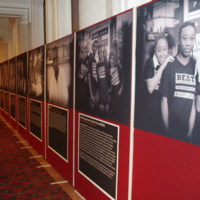
Freedom Roads
The Freedom Roads exhibition at Guildhall Art Gallery was one of several initiatives led by London Metropolitan Archives to mark the bicentenary. The exhibition featured contemporary photographic portraits of people of African origin whose work has contributed to the continuing struggle for human rights in different fields. Colin Prescod, Shirley Thompson, Eric and Jessica Huntley and Rudolph Walker were amongst the individuals featured. Others like the young people from BEAT (Black Experience Archive Trust) were engaged in a project to find out about significant people in their local community. Each person was photographed with an image of an object or place which has a special significance to them. The other part of the exhibition focused on relevant archival materials held by London Metropolitan Archives, including the South African Bill of Rights and a copy of the Constitution signed by Nelson Mandela, Cyril Ramaphosa, F. W. De Klerk and Roelf Meyer. Other material relating to slavery and abolition included a letter from John Julius, a plantation owner on the island of St. Kitts.
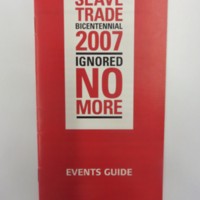
Abolition of the Slave Trade Bicentennial 2007: Ignored No More
The Greater London Authority produced an Events Guide for Londoners in 2007 detailing some of the initiatives taking place in the capital involving the Mayor. This included Africa Day on Trafalgar Square, celebrating the positive contributions of London's African communities, and 'Rise: London United', an anti-racist music festival. The conference 'Faith Symposium: In God's Name?' at City Hall examined the role of the Church in the transatlantic slave trade. There was also a seminar on the legacies of the transatlantic slave trade from a Caribbean perspective and a Caribbean Publishers Book Fair held at London Metropolitan University. The Dr Eric E. Williams Memorial Lecture Series at City Hall was made available as a webcast.
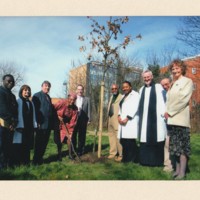
Events led by Leyton and Leytonstone Historical Society
The Leyton and Leytonstone Historical Society led a number of commemorative events to mark the bicentenary. In March 2007 an oak tree was planted in the churchyard of St John’s Church Leytonstone. At the ceremony there were a number of speeches, after which community nurse and local campaigner Mrs Zena Edmund-Charles was invited to plant the commemorative tree. There was also an art exhibition at St John's featuring artefacts and mementos of the period. A commemorative ‘Freedom Walk’ was led by local historian Peter Ashan, following a route around Leyton, Leytonstone and Walthamstow. The exhibition was shown again during Black History Month, alongside a video story of Olaudah Equiano.
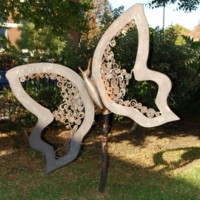
The Freedom Sculpture
The Freedom Sculpture was conceived by Mary Thompson, a teacher at Dog Kennel Hill Primary School in East Dulwich, as a way for the school to mark the bicentenary. Year 6 pupils worked with Kevin Boys, a blacksmith from Surrey Docks City Farm, to translate their ideas of freedom into a visual image. A butterfly was chosen to represent the concept of freedom. Kevin Boys made the butterfly's wings on a mobile forge in the school playground, and Year 5 children designed patterns to place inside. The Freedom Sculpture was opened in the school grounds in November 2008 by Shami Chakrabarti of Liberty, the civil liberties advocacy group.
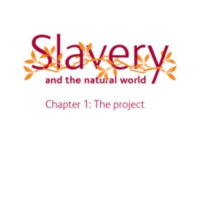
Slavery and the Natural World
In consultation with local community groups, in 2007 the Natural History Museum commissioned new research into its collections that link slavery and the natural world. The research uncovered experiences of enslaved people and the use of plants in their everyday life, as food, medicines and poisons. It also examined the complex relationships between enslaved people and naturalists exploring newly-colonised lands. The museum ran a series of public events, co-hosted by Race on the Agenda, which aimed to bring the historical, scientific and public viewpoints together. It created online educational resources on themes such as Commercial Plants, Everyday Life, Diet and Nutrition, and Resistance. The museum also developed cross-curricular ideas for school lessons in Science using the context of slavery, looking at foods across different cultures, for example.
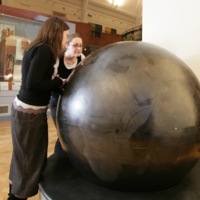
Blue Earth 1807-2007
The sculpture Blue Earth 1807-2007 by African artist Taslim Martin was permanently installed in the newly updated African Worlds Gallery at the Horniman Museum in 2007, to mark the bicentenary. The large iron globe, inscribed with the 18th century image of the slave ship Brookes, traces the routes along which enslaved Africans were transported to the New World, alongside the movement of the products of enslaved labour. The major British ports of Liverpool, London and Bristol are depicted, as well as ports in West Africa and some of the destination ports in North America, the Caribbean and South America. Visitors are encouraged to spin the globe to view slave routes across the world. In 2007-2008, the Horniman Museum also hosted 'La Bouche du Roi' by Romuald Hazoumé.
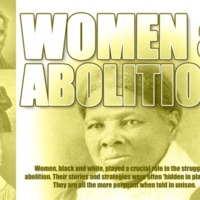
Women and Abolition
Women and Abolition was a collaborative project exploring the role of women in the abolition movement, led by CETTIE (Cultural Exchange Through Theatre in Education) and Yaa Asantewaa Arts and Community Centre. The event in March 2007 included a panel debate, presentations by women activists, poetry and performances of the theatre productions 'Sugar n Spice' and 'Splendid Mummer'.
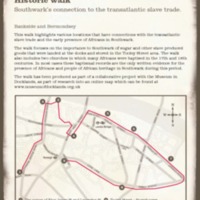
Southwark and Abolition
Southwark Council created two online resources to commemorate the bicentenary. A historic walk, produced in collaboration with the Museum of London Docklands, highlighted locations connected with the slave trade and the early presence of Africans in Southwark. A timeline detailed key dates and events that led to the transatlantic slave trade, including Southwark's local connections to the trade and its abolition. The Cuming Museum in Southwark also held an exhibition, 'Lost and Found'.
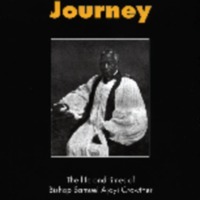
Crowther's Journey: The life and times of Bishop Samuel Ajayi Crowther
Southwark Pensioners Centre Black History Group led a project to explore the life of Bishop Samuel Ajayi Crowther. Born in Yorubaland, Nigeria, kidnapped and sold into slavery, Crowther became the Anglican church's first African-born bishop and an influential missionary in West Africa. The Crowther's Journey project involved weekly research and discussion sessions and visits to places of significance, such as the church of St Mary in Islington, where Crowther was ordained. This booklet focuses on the responses and reflections of members of the group on Crowther, his life and his legacy.
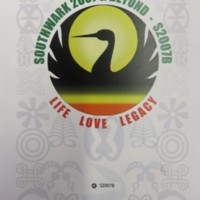
Southwark 2007 & Beyond (S2007B)
The Southwark 2007 & Beyond Steering Group was established to correct perceived misinformation about Britain's role in perpetuating slavery, and to promote education and dialogue on anti-slavery resistance and human rights. The Steering Committee was composed of representatives from Southwark's Afrikan, Afrikan Caribbean and Afro-descendant communities, and the year-long programme of events was funded by Southwark Council. August 2007 was a key month of the commemorative programme, focused on 23 August, the United Nations International Day for Remembrance of the Slave Trade and its Abolition, and the anniversary of the beginning of the Haitian Revolution. A 'Vigil of Remembrance, Resistance and Repairs' included speakers, performances and a libation ceremony. Other events included 'A Bicentennial Dialogue' featuring a keynote address by Dr Joy DeGruy-Leary. The publication 'Abeng Soundings: Abolitionist Landmarks of our Freedom March', co-authored by Esther Stanford of Rendezvous of Victory, provided an overview of the resistance efforts of African freedom fighters against slavery.
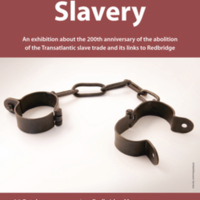
Redbridge and Slavery
Redbridge Museum's exhibition to mark the bicentenary examined the London Borough of Redbridge's connections to the slave trade and abolition. These links included local resident Josiah Child, once Governor of the East India Company, an investor in the Royal African Company and owner of plantations in Jamaica. The Mellish family of Woodford had connections with the West India Docks in London, built for the sugar trade. Alexander Stewart of Woodford owned Jamaican plantations and acted on behalf of owners of enslaved Africans in compensation claims after abolition. The exhibition also examined church records detailing some of the Black residents of Redbridge in the 17th and 18th centuries. Music from the Caribbean island of Dominica was included, as was a series of personal responses to the bicentenary by local residents.
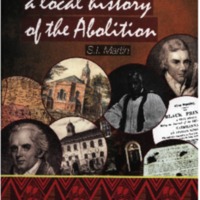
Lambeth and the Abolition
The Lambeth and the Abolition programme included debates, historic trails, a video conferencing discussion between people in Brixton, Ghana and Jamaica, Caribbean family history classes, creative writing workshops, and a dedicated series of events within Black History Month. ‘The Runaways’, an original drama about a runaway slave boy and a kitchen maid in London in 1700, was performed in Lambeth primary schools, accompanied by a workshop. The project researched the local historical links to abolition, and famously the activities of the Clapham Sect (William Wilberforce and his associates) who attended Holy Trinity Church in Clapham. A booklet by historian S. I. Martin sets the history of abolition in the larger context, through his study of the African Academy at Clapham, and his mapping of some of the links between Lambeth, Jamaica and West Africa at the beginning of the 19th century.
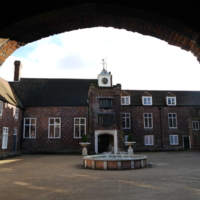
Faces of Freedom: Hammersmith and Fulham and the Slave Trade
The Museum of Fulham Palace is housed in the former palace of the Bishops of London, and former home of Bishop Porteus, the leading advocate for abolition within the Church of England in the late 18th and early 19th centuries. The Faces of Freedom exhibition featured Porteus alongside other individuals associated with slavery and abolition who had links with the area. The abolitionist Granville Sharp lived and is buried nearby, while Crisp Road was named after the slave trader and bead manufacturer Sir Nicholas Crisp. The exhibition included glass beads (very likely produced to be used for barter in Africa) excavated by the Museum of London on the site of Crisp's Hammersmith home. Also featured was the story of Ellen and William Craft, fugitive slaves from Georgia who made Hammersmith their home, and the contributions of local residents Marcus Garvey, Jamaican Pan-Africanist, and nurse Mary Seacole. The exhibition included video footage and posters relating to slavery and freedom, created by pupils from the nearby Phoenix High School.
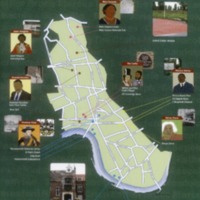
Remembering Slavery in Hammersmith and Fulham
Hammersmith and Fulham Urban Studies Centre is a voluntary educational organisation which offers opportunities to children and young people to learn about the local urban environment. The online curriculum resource 'Remembering Slavery' aimed to inform teaching and learning about the transatlantic slave trade by tracing the links of people and places in Hammersmith and Fulham to enslavement, the slave trade and its abolition. It explored the lives of enslaved Africans and their descendants, detailing their experiences and contributions in the local area. The resource aimed to encourage teachers to develop a locally-based Black history focus across curriculum programmes. It consisted of resource guides and animated films across four broad time frames: pre-Victorian, Victorians, Britain in the 1930s and 40s, and Britain since 1948.
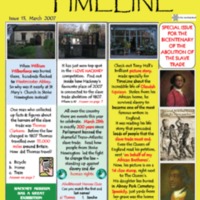
Special issue of TimeLine: Fun and Facts about Stoke Newington and Hackney History and Heritage
TimeLine magazine is a lifelong learning project centred on exploring the history and heritage of Hackney through stories, games, interviews and memories. The magazine is distributed free to schools, libraries and healthcare providers. In March 2007 a special issue of TimeLine examined the bicentenary of the Abolition Act 1807, and Hackney connections to abolition. The special issue included a picture story of the life of Olaudah Equiano.
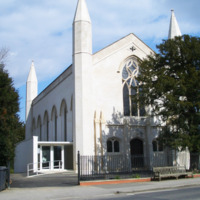
Celebration of the Bicentenary of the Abolition of the Atlantic Slave Trade
After 1825, on leaving Parliament, William Wilberforce retired to Hendon Park in Mill Hill, North London, and during his retirement built a chapel on his estate, now St. Paul's Church. St. Paul's organised a programme of events in 2007 to mark the bicentenary, including concerts by The London Community Gospel Choir and The St. Ignatius Gospel Choir. A series of exhibitions in London Borough of Barnet libraries explored Wilberforce's local connections, and visits to local schools encouraged pupils to express their understanding of slavery and abolition in art, and stressed the need to continue the work of abolitionists today. The programme also included a number of open public meetings with invited speakers exploring different aspects of Wilberforce's life and work, including his collaborations with Thomas Clarkson and John Newton. In 2008 the Wilberforce Centre was opened in the crypt space of St. Paul's.
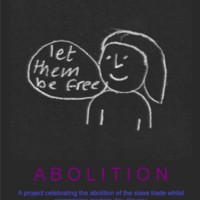
Abolition
Abolition was an art project devised and led by artist Jack Brown, in collaboration with Tidemill Primary School in Deptford. It took place during Black History Month 2007, and aimed to commemorate the abolition of the transatlantic slave trade while recognising the existence of modern day slavery. Every child in the school made a 'step', an artwork representing their perspective on the writing, discussion and petitioning that drove abolition. The children visited the Laban Building at Trinity Laban Conservatoire of Music and Dance and laid their step on the studio theatre floor. Taken together, the steps were conceived as a 'stairway to change'.
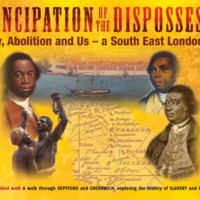
Emancipation of the Dispossessed: Slavery, Abolition and Us - a South East London angle
Emancipation of the Dispossessed was a local community project exploring the local history of Deptford and the surrounding areas and the connections with the transatlantic slave trade. Community groups and students from Lewisham College worked with theatre educators to research and develop 'Blood Sugar', a promenade performance through the Queen's House, Greenwich. The play, written and directed by John Turner, tells the story of slavery and abolition from a local angle, and the script was built around first-hand and eyewitness accounts, campaign pamphlets and reports to parliament. The project also produced learning resources aimed at Key Stage 3 History and Citizenship.
A guided walk explored Deptford’s links to the history of the transatlantic slave trade, uncovering stories of some of the local people who played an important role in the beginnings of the slave trade or the campaign for its abolition. London was an important slave trading port before Bristol and Liverpool dominated the trade. The trade and British colonies were protected by the Royal Navy, whose ships were built and prepared for voyages at the Royal Dockyards at Deptford.
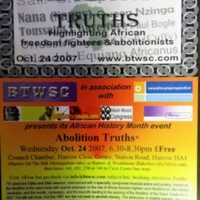
Abolition Truths
Abolition Truths was a panel-led talk and Q&A session at Harrow Civic Centre in October 2007, led by a creative arts community group Beyond the Will Smith Challenge (BTWSC). The event had a particular emphasis on the role of African freedom fighters and abolitionists, the Haitian Revolution, and the revolts, campaigns and boycotts leading to the passing of the 1807 Act. The event was interspersed with music and poetry, including a musical piece 'Then to Now' performed by Africanus Britanicus, and featuring HKB Finn & Co, which told the story of slavery and its legacy across the African diaspora. Teenage poet Stefan Testsola performed a poem on the theme of abolition. There was also a presentation of the Professor Allotey Science Prize, awarded to Harrow students of African descent.
Other BTWSC events in November 2007 included a discussion session with Ms Serwah, 'Putting the Abolition & Slavery Into Perspective' at Willesden Green Library, presented in association with Brent Black History Brent Library. 'From The Talking Drums to Rap & Grime' at Tavistock Hall in Harlesden commemorated the Abolition Act through narration and a musical concert.
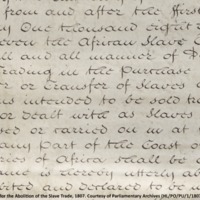
Inhuman Traffic: The Business of the Slave Trade
An exhibition at the British Museum exploring how the transatlantic slave trade functioned. The display examined the commodities involved - tobacco, guns, textiles, sugar, rum - and the ways in which Africa, Europe and the Americas were linked in a global trade network. The exhibition also looked at resistance leaders including Toussaint L'Ouverture, Olaudah Equiano and Nanny of the Maroons, and their struggles to end enslavement. The exhibition was accompanied by a varied public programme at the museum exploring the legacy of the slave trade as part of the Atlantic Trade and Identity season, featuring film screenings, panel discussions, seminars and lectures.